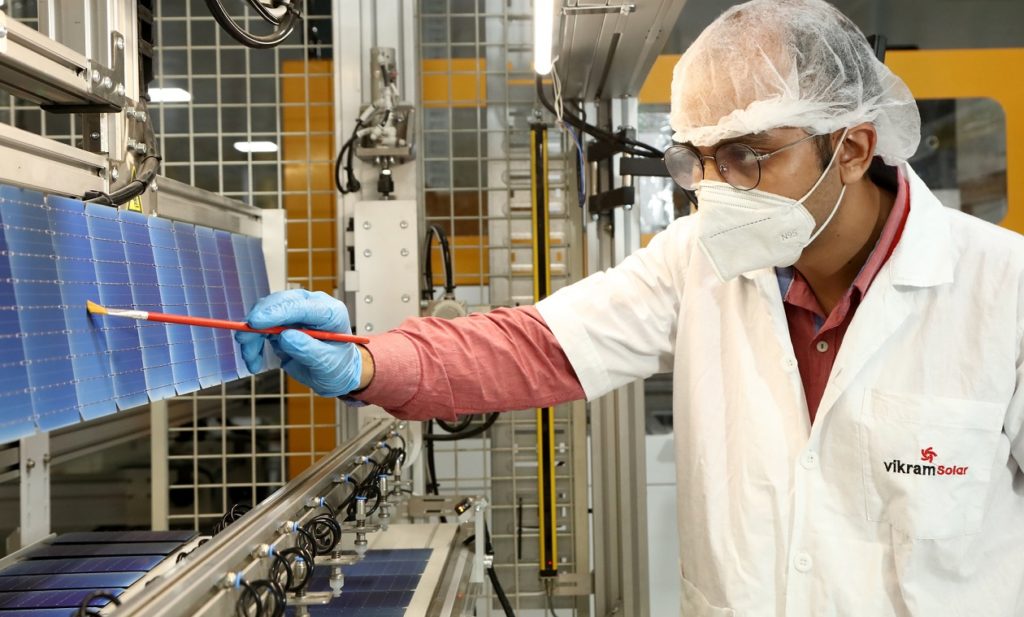
The government of India has released guidelines on the second round of its Production Linked Incentive (PLI) scheme designed to develop greater domestic PV production and slash the country’s reliance on imports.
With its second round approved on 23 September, the scheme intends to add 65GW of manufacturing capacity of fully and partially integrated solar PV modules, which will bring direct investments of nearly INR940 billion (US$11.59 billion), according to India’s Ministry of New and Renewable Energy (MNRE). Indian rating agency ICRA, a Moody’s Investors Service company, put the figure at 40GW of additional cell and module capacity.
Try Premium for just $1
- Full premium access for the first month at only $1
- Converts to an annual rate after 30 days unless cancelled
- Cancel anytime during the trial period
Premium Benefits
- Expert industry analysis and interviews
- Digital access to PV Tech Power journal
- Exclusive event discounts
Or get the full Premium subscription right away
Or continue reading this article for free
The MNRE guidelines said the objective of the scheme was to “build up solar PV manufacturing capacity of high efficiency modules” by bringing “cutting edge technology to India” and to “promote setting up of integrated plants for better quality control and competitiveness”, among other things. It also noted how the scheme would be “technology agnostic”.
The scheme, which is expected to create nearly one million direct and indirect solar jobs, received INR45 billion (US$616.8 million) of funding in its first round allocation but this was then increased more than four-fold to INR195 billion (US$2.4 billion) in February 2021 as India accelerated its PV production plans. The second round placed priority on “fully integrated manufacturing units from polysilicon to solar PV module”.
It will be implemented by the MNRE alongside the Solar Energy Corporation of India (SECI), which will act as the implementation agency with the right to carry out physical inspections of applicants’ manufacturing units and offices.
Applicants can be either a single company, a joint venture (JV) or consortium, although members of a JV or consortium are only allowed to participate in one such collaboration.
Manufacturing hubs can be built on either green or brownfield sites but the latter will only be eligible for 50% of the PLI receivable for greenfield sites. Greenfield sites must be “established in physically segregated premises from any existing manufacturing units”.
Bidders will also need to commit to a minimum level of integration across the solar supply chain. They can bid for any one of the following three baskets, with maximum capacity figures and funding pools given alongside:
- The manufacturing of polysilicon, wafers, cells and modules or a fully integrated thin-film module plant (10GW maximum bid and INR12 billion of funding available).
- The manufacturing of ingots and wafers as well as solar cells and modules (6GW maximum bid and INR4.5 billion of funding available).
- The manufacturing of solar cells and modules (6GW maximum bid and INR3 billion of funding available).
If any funding is left over, it will be distributed across the remaining categories, starting with the most integrated category (i.e. number 1 in the example above and moving down).
However, the maximum capacity awarded will be just 50% of the capacity to be set up under the applicant’s bid, meaning the Indian government will support half the manufacturing base, with the applicant expected to build out the second half on its own.
India’s previous PLI scheme capped bids at 4GW, not 10GW. But following stiff competition for funds, the MNRE decided to change the rules in order to give opportunities to a larger set of players who were exploring market entry or whether to scale up in the sector.
PV producers will also have to satisfy certain minimum values of module performance and local value addition to be eligible for the scheme, the guidelines said. You can explore the precise terms on page seven of the guidelines here.
In their submissions, bidders must also declare the type of technology proposed, their plan for local value addition, the expected employment generation and predicted export figures during the tenure of the scheme.
For precise details and formulas on how PLI incentives are calculated, see pages eight to ten of the guidelines.
The funds will be distributed for five years from the commissioning of the manufacturing site or five years from the scheduled commissioning date, whichever is earlier, and a team from MNRE and SECI will visit the facility immediately to confirm its set-up is in line with PLI rules.
Manufacturers will also be required to establish facilities for the recovery and recycling of solar waste as well as adopting circular economy principles.






